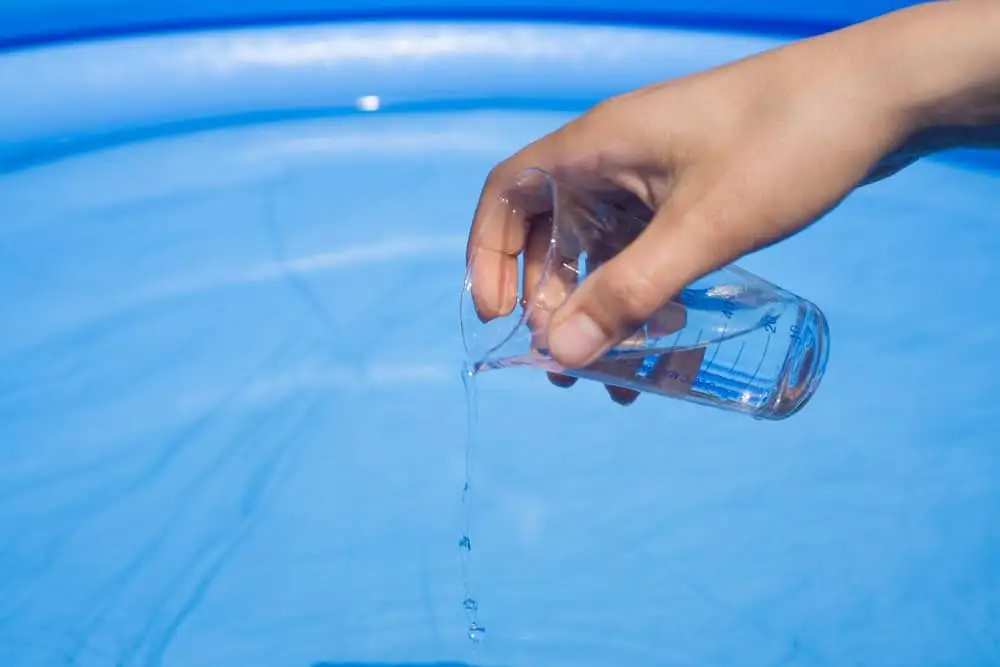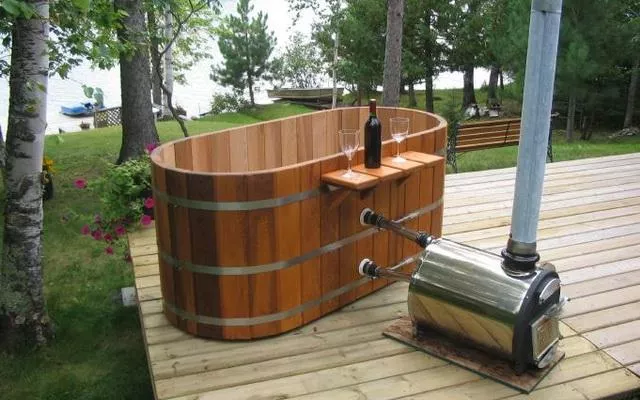This article is your guide on how to heat your pool cheaply. We think that the best and cheapest way to heat your pool is with a pool heat pump! We will cover multiple ways that will help if you’re contemplating a heated in-ground or an above-ground pool. We hope you find options to heat your pool on a budget without a hefty investment in a heater. So let’s find out the top 8 ways to heat your pool!
Here at The Energy Professor, we want to give you the information you need to save money on your energy bill and become more energy efficient. We hope you find this post helpful and makes you more confident in your ways to heat a pool cheaply. Be sure to also check out our one-of-a-kind energy savings calculator!
The Energy Professor Electricity Rate Check Tool
What are the Cheapest Ways to Heat a Pool?
The cheapest way to heat your pool is with a pool pump. A decent pool pump will cost you somewhere between $2000 – $4000, but that is the cheapest way to do it! It is also one of the most reliable ways on how to heat your pool cheap, which we will cover in this article.
The 8 cheap ways to heat pool on our list will range in price. But most will be made up of non-electric heating systems. We will also discuss how to raise pool water temperature and how much these options heat the pool cheaply. Below are the cheapest options to heat a pool.
#1 – Pool Heat Pump
- Uses minimal electricity to transfer heat from the air to the pool water.
- Highly efficient and cost-effective over time.
#2 – Solar Pool Cover/Blanket
- Traps the sun’s heat and prevents water evaporation.
- Can raise pool temperature by 10-15 degrees Fahrenheit.
- Inexpensive and easy to use.
#3 – Combine Pump and Cover
- Use a solar pool cover in conjunction with a heat pump for maximum efficiency.
- Reduces heat loss and enhances the heating effect.
#4 – Solar Sun Rings
- Inflatable rings that float on the surface, absorbing and transferring solar heat to the water.
- Easy to use and effective in maintaining warmer water temperatures.
#5 – Liquid Solar Pool Cover
- Creates a thin, invisible layer on the water surface to reduce evaporation and heat loss.
- Simple to apply and cost-effective.
#6 – Black Hose Trick
- Coil a long, black garden hose in direct sunlight, with one end connected to the pool pump and the other returning warm water to the pool.
- An affordable DIY method to raise water temperature.
#7 – Fire Heater
- Utilize a wood-burning fire heater or fire pit nearby to transfer heat to the pool water.
- Creative and low-cost heating solution.
#8 – Build an Enclosure
- Construct an enclosure or greenhouse around the pool to trap heat.
- Helps maintain warmer temperatures by reducing heat loss due to wind and evaporation.
Related Post: 8 Tricks to Reduce Your Energy Bill
#1 – Pool Heat Pump
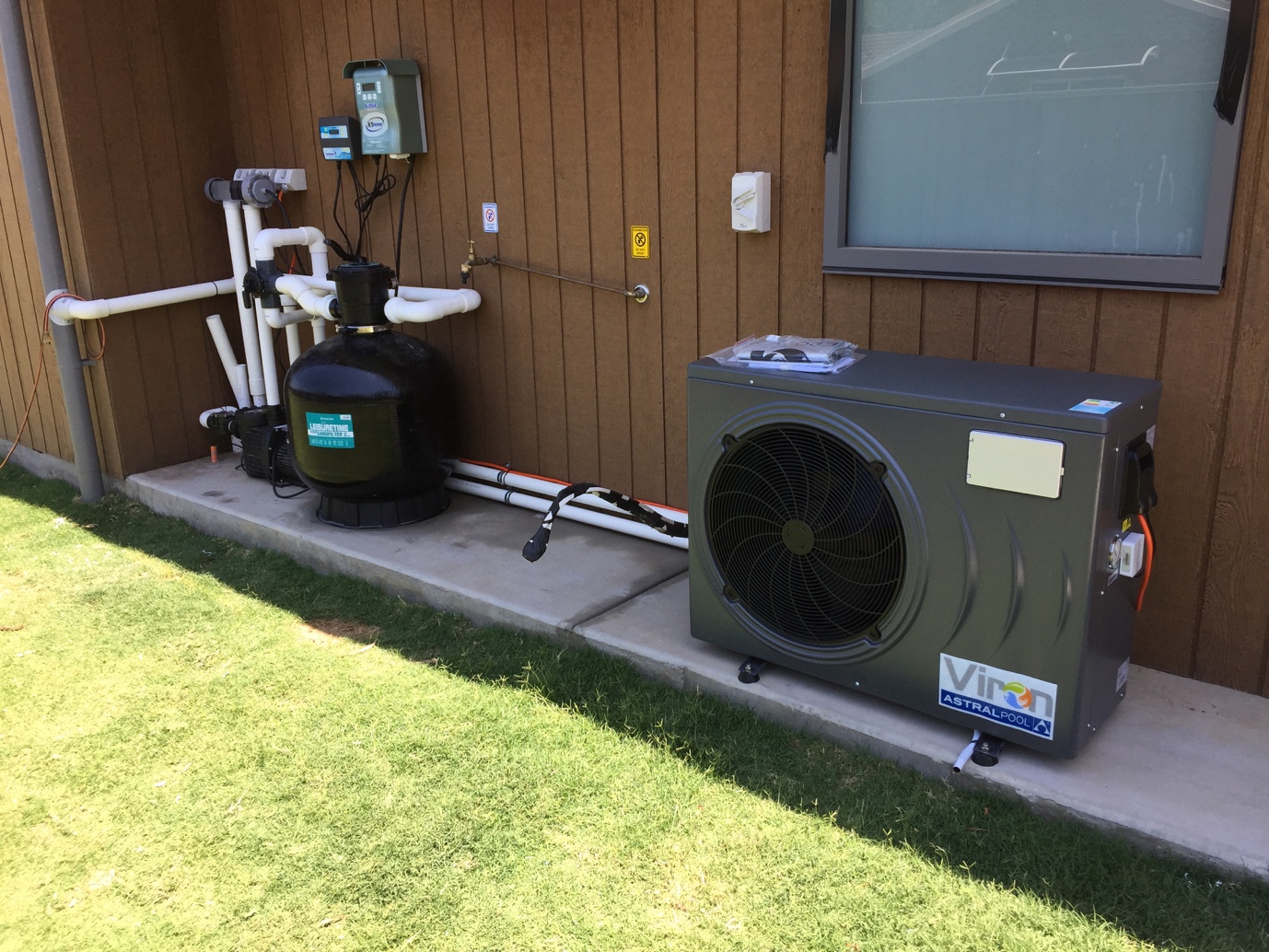
Price: $2,000 – $5,000 (minus installation cost)
Temperature: 78 – 82 degrees
Pros: This is the most energy-efficient electric option. When choosing an electric option, you have to take into consideration how long it takes to heat a pool. A pool heat pump will take about 24 kWh per day, or around 720 kWh per month, just running only 10 hours per day. This cost will depend on how much you pay for energy per kWh. But for example, if your energy rate is $0.11 per kWh you’ll pay about $80 per month in energy costs to heat your pool.
Cons: Because pool heat pumps work by taking in air that is already warm, they work best in humid areas where the ambient temperature stays above 60 degrees Fahrenheit.
Important to Know: Although the upfront cost for a pool heat pump is high, this option is more of an investment than a short-term payoff. After using a pool heat pump for 2 years, you will start seeing the savings of this option. The lifespan of a pool heat pump is about 8 to 13 years. Within this time frame, you will save about $5,000 in total cost compared to other more expensive options. If you are planning on staying in your house for over 2 years a heat pump would be a great option when heating a pool cheaply.
Related Post: How Many Watts in One Kilowatt Hour
#2 – Solar Pool Cover
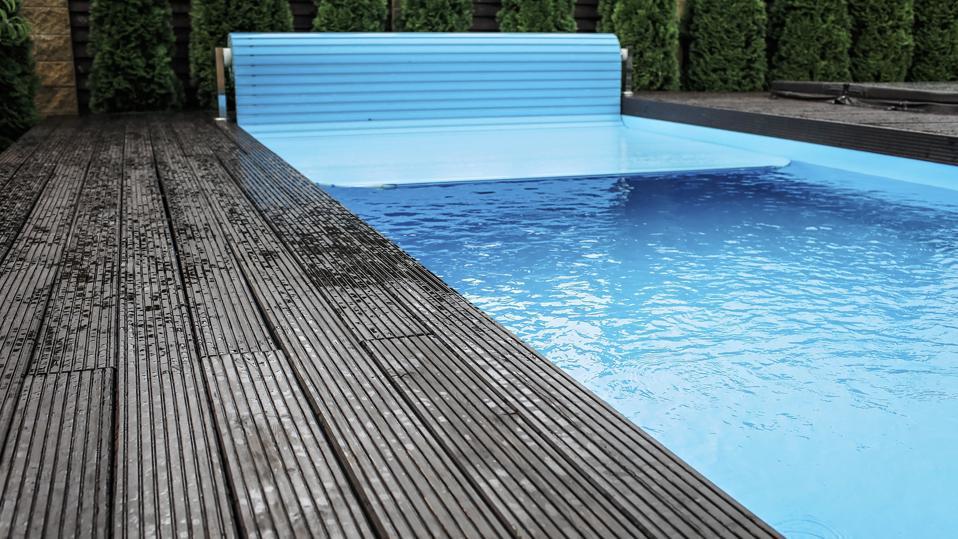
Price: $75 – $225
Temperature: Water temperature can increase up to 15 degrees. This is one of the cheapest ways to heat a pool based on the price and it can increase your pool temperature by 15 degrees.
Pros: This is a completely energy-free way of heating your pool! Solar blankets use the heat from the sun to heat your pool water. They not only bring warmth into the pool, but they keep it from escaping the pool too!
Cons: For your pool to heat up using a solar blanket, the outdoor temperature must be at least 15 degrees warmer than your current water temperature.
Important to Know: When looking to heat water in the pool, a solar cover can be a great breeding ground for algae. So make sure your water chemistry is manageable and within the base limits or you can see some growth. If water chemistry isn’t your strong suit, we recommend leaving 80-90% of your pool uncovered. If you’re wondering how long it takes to heat a pool using a solar cover, it will take a minimum of 6 hours for your water to start warming up. If you are wondering “How can I heat my pool for free?” After the initial cost of this solar pool cover, it is a free way to heat your pool!
Related Post: Complete Guide to Solar: Pros and Cons
#3 – Combine a Pump & Solar Cover
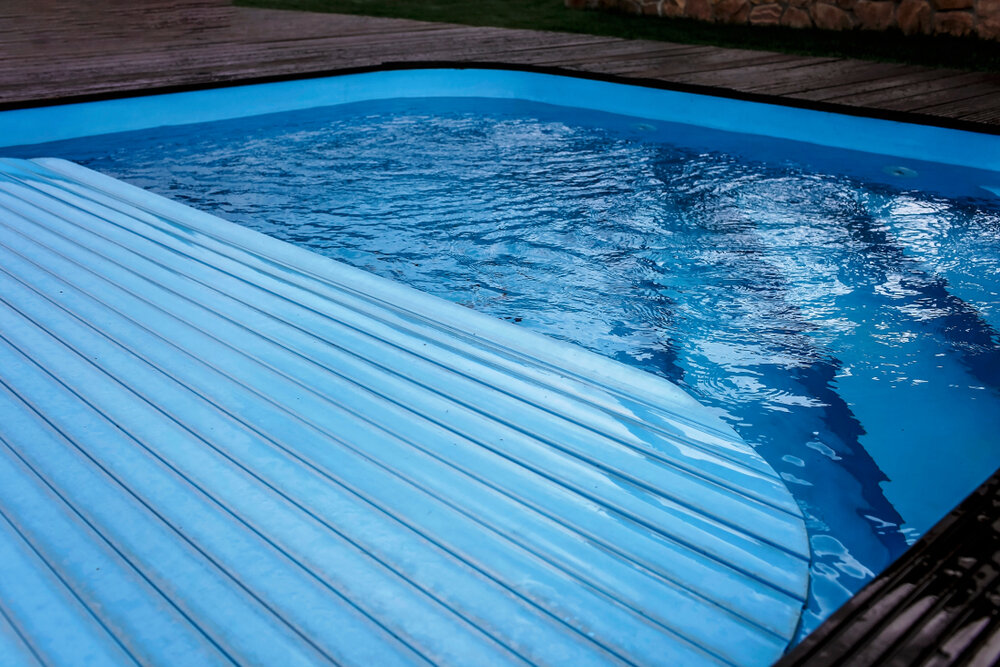
Price: $2,075 – $5,225
Temperature: 78 – 82 degrees
Pros: This is the best of both worlds! But unlike Hannah Montana, you won’t have to hide your joy of having a warm pool all year round. In all seriousness, this option will save you even more money. A pump with a cover will mean you do not have to run your pump heater as many hours cutting down on your electric bill! This is one of the best ways to heat an outdoor pool to save you money in the long run.
Cons: Purchasing two forms of heating systems is a hefty investment. However, you can split it up and always purchase a solar blanket at a later time if needed.
Important to Know: The biggest question we receive is, can you run a pool pump with a solar cover on it? Yes! You can have both of these systems running at the same time! Your solar cover will not interfere with your pump heater in the slightest. But how long to heat a pool with both systems? Using your heat pump with the solar cover on can reduce the amount of time it takes to heat your pool by hours! This can differ depending on the size and type of your pool.
Related Post: How Much Power Does a TV Use?
#4 – Solar Sun Rings
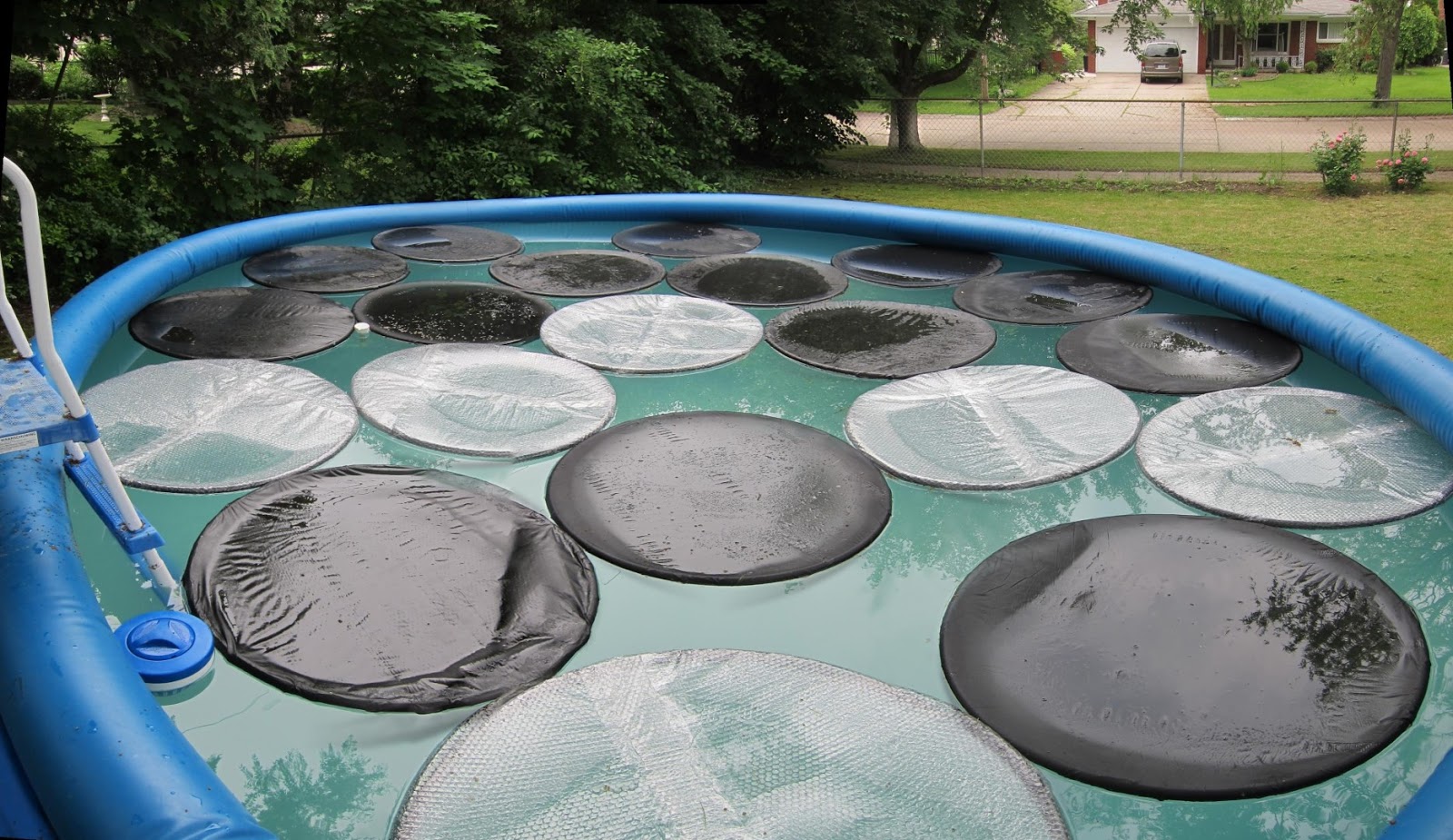
Price: $37 per 5 foot ring
Temperature: Water temperature can increase up to 15 degrees
Pros: A Solar Sun Ring is a great option when you’re asking yourself what is a cheap way to heat above above-ground pool or an in-ground pool. Not only is it a great option price-wise, but you also can cover as much as you want of your pool. In comparison to a solar blanket which has to cover the entire surface of the pool. It also is a great option if you don’t have any or very little room to install a pool cover making it great for heating a small pool. The Solar Sun Rings are each only a 5-foot circumference and can be stored in smaller spaces making it one of the best cheap ways to heat pool.
Cons: The area of surface coverage isn’t as helpful at warming pool water. Solar Sun Rings only cover 70%-80% of your surface area. Meaning that 20%-30% of your water is exposed to the sun’s rays. Sure the sun will also heat your pool, but the amount of heat that evaporates from those gaps will cancel out the heat coming in from the sun.
Important to Know: One important thing to know when considering a Solar Sun Ring is the lifespan. On average, users of Solar Sun Rings said they last around 1 year until needing to be replaced. Most of the replacement needs are from losing the Sun Rings in high winds, or becoming destroyed with dust and debris.
Related Post: Why is My Electric Bill so High?
#5 – Liquid Solar Pool Cover
Price: $30
Temperature: A liquid solar pool cover can typically increase the water temperature by a few degrees Fahrenheit (or a couple of degrees Celsius). Its purpose is to reduce evaporation and heat loss from the pool, as well as to enhance solar heating.
Pros: If you’re looking for one of the cheapest ways to heat a pool without putting something on top of your pool, a liquid pool cover is the way to go. These are especially great if you live in an area that has a lot of strong winds or storms.
Cons: This option can get quite expensive over time. To maintain the heat in your pool, you must add one bottle per month to keep this liquid cover active. That’s $360 a year which is more than most solar blanket covers. So this comes down to the aesthetic you’re going for with your pool usage.
Important to Know: A liquid solar pool cover, also known as a solar pool blanket or a liquid pool cover, is a thin, liquid-based product that is added to the surface of a pool. Liquid pool covers don’t heat water in the pool. It acts as a barrier that helps prevent heat from evaporating from the top of your pool. We only really recommend this product for homeowners in areas where it stays above at least 70 degrees at night all year long.
Related Post: Top Energy-Saving Devices for Your Home
#6 – Black Hose Trick
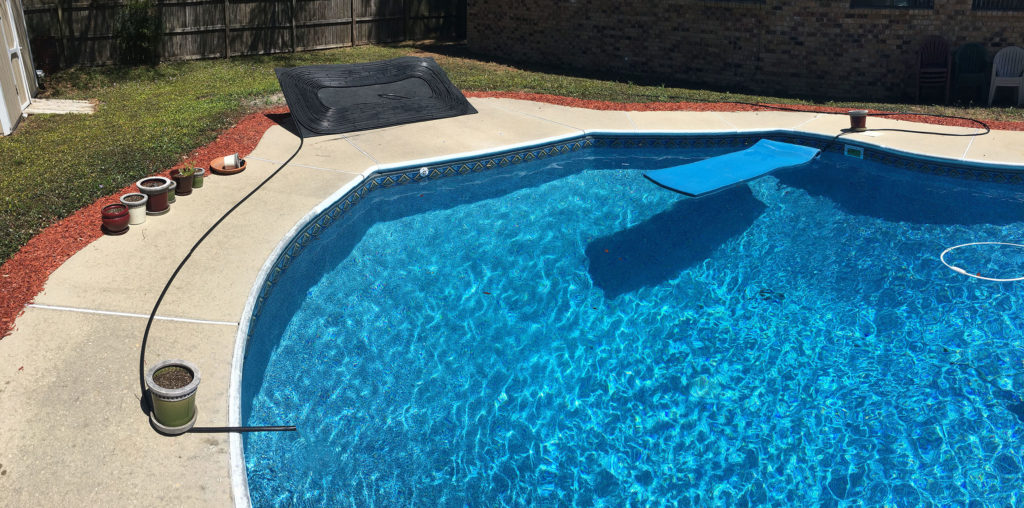
Price: $25 – $300
Temperature: 4 degrees warmer
Pros: Depending on the black hose heater you get or make, this can be a great way to inexpensively heat your pool! This is a great option if you live in an area with little shade and can have your hose in direct sunlight. For maximum results, you should leave your hose in the sun for the entire day.
Cons: It doesn’t warm your pool, a significant amount. While this can be a great way to heat your pool, the conditions have to be perfect to do the job.
Important to Know: If you’re wondering how a black hose can heat your pool, it’s all about heat retention within the hose. It’s one of the easiest ways to heat your pool yourself. All you need is a long black hose, preferably about 50 feet in length. The hose will sit in direct sunlight all day heating the water within the hose. Once the water is warm, release the water from within the hose into your pool! You can continue filling your pool with this warm water until the temperature declines. The hose should be hot enough to heat the water as it passes through it into the pool.
Related Post: How to Calculate Your Electricity Cost
#7 – Fire Wood Pool Heater
Price: $120 – $250
Temperature: 60 – 70 degrees
Pros: This is a great option if you love to DIY things around your home as much as possible. It is possible to have a DIY pool heater fire. It may take a bit longer than the other options on this list to install, but if it’s worth it to you, it works! If you’re looking for a great step-by-step guide to build your own fire pit pool heater, check out this helpful guide!
Cons: Again, not the most cost-efficient option on this list. It also can take quite a bit of time to build and install. So make sure to keep those factors in mind when considering this option to heat the outdoor pool.
Important to Know: While you can build a fire heater for an in-ground pool, it will take previous planning and more construction to install before the pool is in the ground. That’s why we only recommend this option if you’re asking, can you heat an above-ground pool with a fire heater? Above-ground fire heated pools are much easier to complete and don’t require you to plan. This way it can be put in as an option after you’ve tried other options first.
Related Post: Complete Guide on How to Recycle Your Lightbulbs
#8 – Build an Enclosure
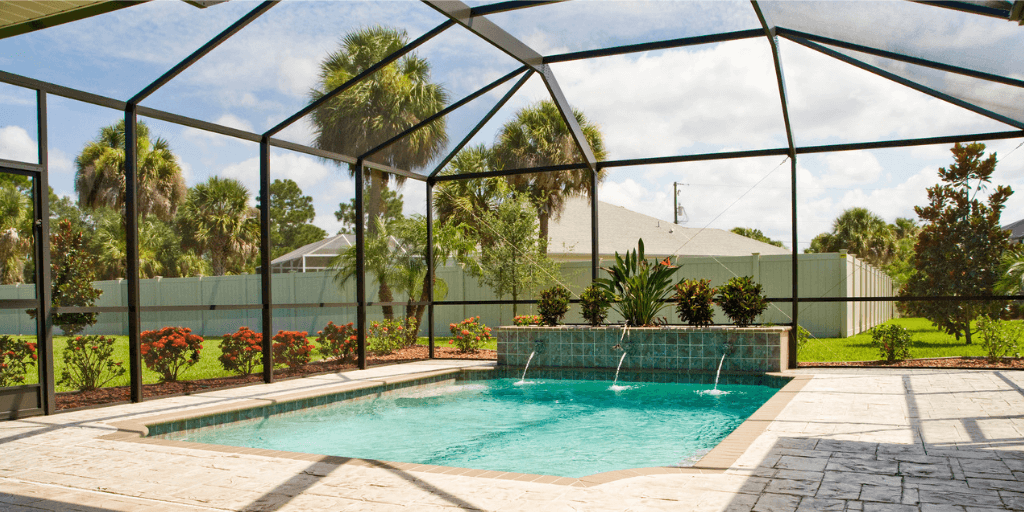
Price: $4,000 – $14,000
Temperature: 0 degrees
Pros: This type of “heater” will allow you to use your pool all year round! Therefore, getting much more value out of the money you spend to install a pool in the first place.
Cons: This option can take up most of your yard. It is also by far one of the most expensive options on this list.
Important to Know: This can be a great option if you’re looking at how to heat a pool without a heater. Similar to the liquid pool cover, this option doesn’t directly heat your pool. It acts as a barrier to the elements that reduce the temperature of your pool. The only reason we wanted to put this on the list is to give you the option that best fits your home and your pool needs. It can also reduce heating and water costs, and chlorine use, by almost 75%!
Related Post: Find the Best Pool Enclosure Nearest You!
Heat a Pool Cheap FAQ

Q: How Long Does it Take to Heat a Pool?
A: This depends on the type of heating method you choose to use. On average, you can expect it to take a minimum of 12 – 48 hours to heat your pool. Heating your pool is no small feat! We would say to expect it to be on the longer end of that range to be temperate. And another day or two to be a comfortable temperature.
Q: What is the Normal Heated Pool Temperature?
A: For your water to be a comfortable temperature, you’d want to keep it below your body temperature. We would recommend maintaining your pool temperature to be between 78 and 82 degrees F. That way it’s cooler than your body temperature by enough degrees to still be refreshing. Especially on those hot summer days!
Q: How to Heat a Swimming Pool for Free?
A: There truly is no “free” way to heat your swimming pool unless you only rely on UV rays from the sun. Even then, the amount of evaporation you’d receive in water will result in needing to fill your pool with cooler water. The best way to beat this cycle is if you use the black hose trick. Use the warm water from the black hose to fill up your pool.
Q: How Much Heat Does a Pool Lose Overnight?
A: On average, if you live in an area where the nightly temperature dips below 70 degrees F, you can expect your pool to lower 4-5 degrees Fahrenheit. A great way to stop this from happening is with a solar blanket. This is one of the only heating alternatives that will reduce the heat that is being evaporated from your pool overnight.
Q: What is the best way to heat a pool without a heater?
A: A solar pool cover is a completely energy-free way of heating your pool! Solar blankets use the heat from the sun to heat your pool water. They not only bring warmth into the pool, but they keep it from escaping the pool too!
Q: What is the cheapest way to heat an inground pool?
A: When looking for cheap ways to heat your inground pool, using anything that takes advantage of solar energy is a good affordable option since it does not use electricity. Solar covers are the cheapest way to heat your pool. Although it may have a large upfront cost, it will save you money in the end compared to purchasing a heater.
Do you Need Cheaper Electricity?
If you’ve taken the time to understand the information on your bill and discovered you’re paying more than you’d like for your electricity, have you looked around for a cheaper deal? The Energy Professor has a wealth of information on ways to save on your utilities, including details of top deals that could significantly reduce your monthly or quarterly electricity bills.
We hope you found this article helpful! If you are looking for ways to increase energy efficiency and sustainability in your home be sure to take a look at all of the latest renewable energy options in your area. The Energy Professor helps residential and small business owners find qualified energy suppliers in New York, New Jersey, Pennsylvania, Texas, Ohio, Maryland, Illinois, and Massachusetts.


